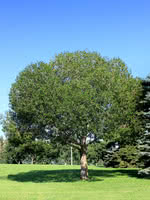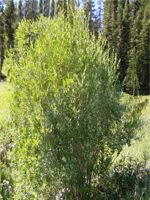Mon-Fri 9am - 5pm Mountain time
Laurel Leaf Willow vs Bebbs Willow
Salix pentandra
Salix bebbiana
Laurel Leaf Willow is a round-shaped tree with attractive dark green leaves.
This cold hardy tree can withstand bitter winters and still put on lots of growth every summer. Laurel Leaf Willow prefers moist to wet ground and full sun, though it can tolerate partial shade too. This species is also known as one of the more salt-tolerant species for those with saline soils.
All willow are important to native pollinators each spring as they have higher amounts of pollen and nectar early each growing season when other food sources are scarce.
This large shrub is native to all of Canada and most of the United States. Its leaves are green on the top and grey on the bottom, and it produces catkin based flowers and non-edible fruit which appears very similar to a group of pine needles.
Bebb's Willow is foraged for by many species including elk, hares, beavers and various birds. It is commonly used to prevent erosion and protect aquatic environments due to its preference for shady, moist environments.
Laurel Leaf Willow Quick Facts
Bebbs Willow Quick Facts
In row spacing: 2.4 - 3 m (8 - 10 ft)

